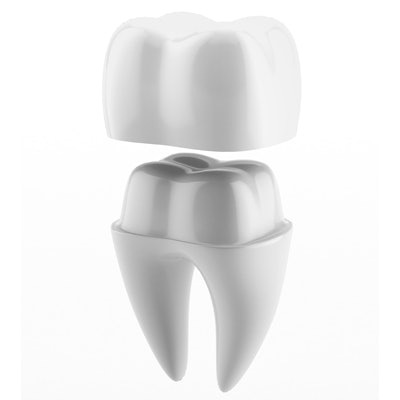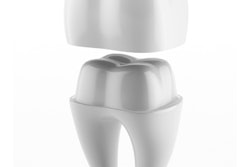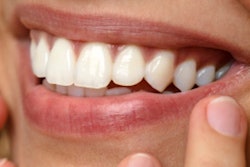
As the number of restorative materials used in chairside CAD/CAM has increased, so too has the need for practitioners to be aware of which materials remain the strongest after grinding with a diamond disk.
In a comprehensive examination, researchers from Switzerland assessed the surface and subsurface damages induced by three grades of diamond grits on five restorative materials using a Cerec milling unit (Dentsply Sirona). They found that a couple of the so-called softer materials generally had smaller chips and less, if any, loss of strength than the three glass-ceramic materials tested.
"The chip sizes and associated cracks created for each material are dependent on the pressure and diamond grit size," the authors wrote (Dental Materials, March 2017, Vol. 33:3, pp. 294-308).
The study was led by Philippe Curran of the division of oral and maxillofacial surgery, unit of oral surgery and implantology, in the department of surgery at the University of Geneva & University Hospitals of Geneva.
Strength reduction
As chairside CAD/CAM becomes more common for creating restorations such as single crowns, inlays, onlays, and veneers, a multistep grinding and polishing process is required to prepare the restoration. The researchers sought to measure the type of chip damage that would occur in several CAD/CAM ceramics and also attempt to estimate the potential loss of strength.
Generally, after a restoration is ground, it is polished to remove any damage caused during the grinding process. When microcracks occur during the grinding process, there is a reduction in the material's strength, which can lead to a possible failure of the restoration.
The researchers used diamonds of medium (75 µm), fine (54 µm), and superfine (18 µm) grits on five chairside CAD/CAM restorative materials:
- Lithium disilicate glass-ceramic (e.max CAD, Ivoclar Vivadent)
- Leucite glass-ceramic (Empress CAD, Ivoclar Vivadent)
- Feldspar ceramic (Vita Mark II, Vita)
- Feldspar ceramic-resin infiltrated (Enamic, Vita)
- Composite reinforced with nanoceramics (Lava Ultimate, 3M)
The researchers cut a pair of 3 x 4 x 12-mm slices from the original CAD/CAM blocks for all five materials and undertook a multistep grinding, polishing, and bonding process for all blocks.
The surfaces were ground with hand pressure using the diamond disks mounted on a turntable. The ground surfaces were further polished with diamond pastes of 6 µm, 3 µm, and 1 µm at 150 rpm rotation speed for three minutes each. The blocks were then ultrasonically cleaned before analysis with a scanning electron microscope.
The researchers measured maximum and average damage chip depths and made a calculation of fracture stresses. They compared these stresses with the manufacturer's reported strength value for each material to estimate potential losses in strength from grinding damage.
The measured average chip sizes with standard deviation (mean ± SD) for the materials are listed in the table below.
| Average chip sizes | |||
| Brand | 75 µm diamond grinding damage | 54 µm diamond grinding damage | 18 µm diamond grinding damage |
| E.max CAD | 100.2 ± 35.9 µm | 84.1 ± 44.7 µm | 42.8 ± 13.8 µm |
| Empress CAD | 94.2 ± 34.0 µm | 59.6 ± 19.4 µm | 15.1 ± 7.6 µm |
| Vita Mark II | 106.5 ± 53.1 µm | 51.3 ± 12.8 µm | 10.2 ± 3.6 µm |
| Enamic | 25.8 ± 10.8 µm | 18.3 ± 6.3 µm | 7.0 ± 1.3 µm |
| Lava Ultimate | 16.6 ± 7.5 µm | 7.1 ± 2.0 µm | 4.8 ± 1.5 µm |
E.max CAD
The researchers found that e.max CAD showed "important" chipping after diamond disk grinding. Grinding with 18-µm diamond disks was quite detrimental for this material, with average chip sizes of 43 µm, the authors noted.
The material also showed an estimated strength loss of between 40% and 60%, they added.
“Careful polishing steps should be carried out after grinding, especially when dealing with glass-ceramics.”
Empress CAD and Vita Mark II
Empress CAD and Vita Mark II also showed what the authors described as "major" chipping after grinding. Empress CAD had a reported strength loss of between 34% and 47%, while Vita Mark II's strength loss was lower at 33%.
The strength loss estimate should not be considered as a "true value" but as a potential loss value, the authors noted.
Enamic and Lava Ultimate
The so-called softer materials generally fared better than the glass-ceramic materials. Enamic showed "only minor suffering" from grinding-induced chipping damage. Polishing, however, is mandatory to obtain the needed smooth surface, the authors pointed out.
Lava Ultimate likewise showed little damage from grinding-induced chipping with no loss in strength, they reported.
Manufacturer recommendations
The authors stated that manufacturers seem to be aware of roughness and possible chip damage left by the milling unit or grinding modifications, and they have prepared specific polishing protocols for their ceramic products.
"Dentists and dental laboratories need to ensure such polishing procedures, keeping in mind that margins are those that will suffer the most from edge chip damage," the authors wrote.
As a potential limitation, they noted that their study used only hand pressure by one operator on a turntable with water lubricant without moving the specimen. The size of chips that formed may vary for another operator using hand pressure.
Practitioners needed to be diligent about the polishing process, the authors noted.
"Careful polishing steps should be carried out after grinding, especially when dealing with glass-ceramics," they concluded.



















